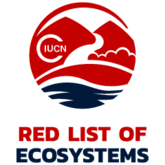EFG T7.4 Urban and industrial – current maps
T7. Intensive land-use biome
This page provides information about the valid indicative distribution map for the ecosystem functional group T7.4 Urban and industrial ecosystems. For older or alternative maps, see here.
Methods
Here is the methods summary for Map code and version: T7.4.web.orig v1.0.
The indicative distribution of Urban and infrastructure lands was estimated using spatial data for night light brightness (values >0 in NCEI 2019; Cinzano, et al. 2019)
Datasets
ESRI-2020-Landcover (Karra et al. 2021):
Source of spatial indicator. Resolution: <1km2, static. Accuracy evaluation: >90%.
Processing
Processing steps used in this map are: Reclassification :: Thresholds :: Buffering.
Map evaluation
This map is considered to be a Fine quality map based on the following characteristics:
Concept alignment is Direct,specific.
Ground observations are NA.
The accuracy evaluation Quantitative accuracy assessment,documented,quantitative.
How to use the data
Available files
You can download geospatial data for this map from the following repositories:
- Indicative Map (code: T7.4.WM.nwx, version v1.0)
Alternative links for accessing the maps in different formats:
T7.4.WM.nwx (v1.0): Google Cloud bucket :: Mapbox tileset
Note that you need to login to some services like mapbox or earthengine, and in some cases you also need to request access to the files.
Reproducible code
Code to reproduce the maps from the source datasets is not available at the moment.
License information
Indicative maps have been released with a Creative Commons Attribution 4.0 International license.
Datasets used to create this map have similar licenses, but please check the license information below.
| dataset | license_info |
|---|---|
| ESRI-2020-Landcover | Creative Commons BY-4.0 license |
References
References used in this version of the maps.
- Karra, Kontgis, et al. (2021) Global land use/land cover with Sentinel-2 and deep learning IGARSS 2021-2021 IEEE International Geoscience and Remote Sensing Symposium IEEE
